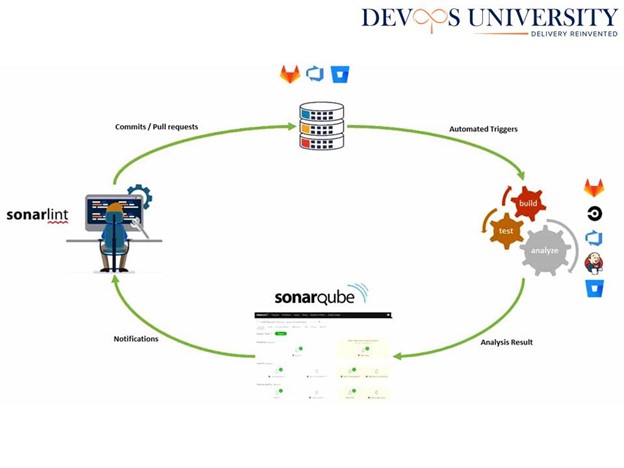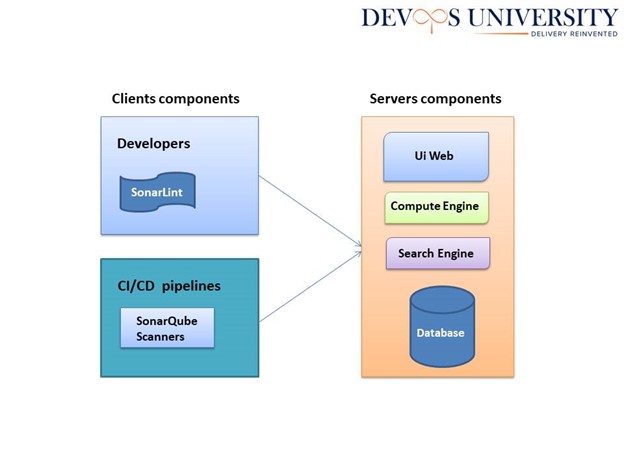
SonarQube is an open-source tool for ongoing code quality inspection. It analyses static code and generates a complete report with details on defects; code smells, vulnerabilities, and duplications. SonarQube delivers clear remediation recommendations for developers to understand and solve errors and for teams to build better, safer software by covering 27 programming languages and integrating with your existing development workflow. SonarQube delivers the means for all groups and corporations worldwide to own and affect their Code Quality and Security, with over 170,000 installations assisting small development teams and multinational organisations.
Why use SonarQube?
SonarQube is a code quality assurance tool that collects and analyses source code and generates reports on your project’s code quality. It combines static and dynamic analytic technologies and allows continuous quality monitoring throughout time. The software will examine source code from various angles and dive down layer by layer, from module to class level, with each level producing metric values and reports.
By eliminating complexities, duplications, and potential flaws in the code and maintaining a nice and clean code architecture, and increasing unit tests, the SonarQube platform considerably extends the life of applications. In addition, SonarQube improves the software’s maintainability. It is also capable of adapting to changes.
Quality Gates In SonarQube
SonarSource provides the Sonar way Quality Gate, which is activated by default and is regarded as built-in and read-only. SonarQube is an excellent tool for analyzing code quality and finding code smells, bugs, vulnerabilities, and low test coverage using static analysis. A quality gate is a series of conditions that must be completed for a project to be marked as passed in SonarQube. By focusing on new code, this Quality Gate is the ideal approach to implement the clean as you code concept. You can use the Quality Gate to enforce ratings (reliability, security, security review, and maintainability) based on overall and new code metrics. The default quality gate includes these criteria. Quality Gates evaluates all of a project’s quality metrics before assigning a passed or failed label. You can create a default Quality Gate that will be applied to all projects that aren’t expressly assigned to another gate.
Features of SonarQube in DevOps
SonarQube inspects everything from minor styling details to critical design errors, allowing developers to continuously access and track code analysis data ranging from potential bugs, code defects, and styling errors to design inefficiencies, and lack of test coverage, code duplication, and excess complexity.
- The Sonar platform analyses source code from several perspectives and drills down to your code layer by layer, from the module level to the class level, providing metric values and statistics and highlighting faults in the source code at each level that must be addressed.
- Within a short period, SonarQube decreases the risk of software development. It automatically discovers issues in the code and notifies developers to repair them before releasing them into production.
- SonarQube additionally shows complex code regions that aren’t covered by unit tests. Finally, SonarQube integrates seamlessly with your Azure DevOps environment to find bugs, security flaws, and code smells.
- SonarQube inspects and evaluates everything from small stylistic choices to design mistakes. This gives users a rich, searchable history of the code, allowing them to figure out where the code is going wrong and whether it’s due to style issues, code failures, code duplication, a lack of test coverage, or overly complex code.
- It shows you what’s wrong, but it also provides quality and management tools to assist you in resolving problems actively.
- Focuses on more than simply bugs and complexity, including features like coding guidelines, test coverage, de-duplications, API documentation, and code complexity, all accessible from a single dashboard.
- Provides a view of your code quality right now and historical and anticipated future quality indicators. It also includes stats to assist you in making the best judgments possible.
- Sonarqube ensures code dependability and application security and eliminates technical debt by making your codebase clean and maintainable. Sonarqube also supports 27 languages, including C, C++, Java, Javascript, PHP, Go, Python, etc. In addition, SonarQube integrates with Ci/CD and provides code review input via branch analysis and pull request decoration.
Benefits of Using SonarQube
Sustainability- Reduces complexity, potential vulnerabilities, and code duplications, extending the life of applications by maintaining a clean code design and increasing unit tests. It makes the software more maintainable. It is also capable of adapting to changes.
Increase productivity- Reduces the application’s scale, cost of maintenance, and risk, removing the need to spend more time modifying the code.
Quality code- With SonarQube, code quality becomes a well-known aspect of the development process.
It allows for continuous code quality control while lowering the cost and risk of software management.
Developers are given helpful information to guarantee that this is widely used.
Detect Mistakes- SonarQube automatically discovers defects in the code and notifies developers so they can fix them before releasing them to the public.
Scalability- SonarQube is built to scale with your business’s demands. There is yet to be discovered a limit to its scalability.
SonarQube has been put through its paces. It regularly analyses over 5,000 projects with over four million code lines and twenty developers.
Raise Quality- SonarQube uses multi-dimensional analysis to get results for the seven code quality sections described earlier. It aids developers in minimizing code duplication and keeping code complexity minimal. Developers can construct personalized dashboards to concentrate on the essential areas. It aids in the timely delivery of high-quality goods.
Establish and Increase Requirements Efficiently- It features a set of preset standards that allow developers and software managers to assess the quality of their applications quickly. In addition, it is easily configurable to meet the specific needs of the company or team.
Encourage innovation- As more businesses transition to the SonarQube platform, their size and diversity expand. As a result, these businesses can alter and extend the platform’s functionality. In addition, companies may access a growing number of plugins and an extensive developer network.
Enhance developer skills – SonarQube adds tremendous value to development teams and is thus quickly embraced. Developers receive regular feedback on code standards and quality issues, which aids in their development. In addition, it ensures code transparency and provides a clear understanding of software quality.
Conclusion
SonarQube is a code quality assurance tool that collects and analyses source code and generates reports on your project’s code quality. It combines static and dynamic analytic technologies and allows continuous quality monitoring throughout time.
Static code analysis is an excellent tool for improving code quality, lowering technical debt, and reducing the risk of vulnerabilities. SonarQube’s implementation capabilities and its other features give it a complete platform for automating and supporting team members working on this project. Unfortunately, it can turn into a despised and cruel tool when misused. Nevertheless, it can make straightforward recommendations that are worth considering. SonarQube is an excellent technical tool that helps the team when utilised correctly.




 Workshop on Certified DevOps Foundation
Workshop on Certified DevOps Foundation Workshop on Certified DevOps Professional
Workshop on Certified DevOps Professional Get DevOps Certified
Get DevOps Certified